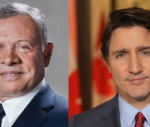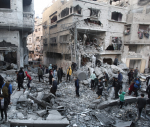You are here
Sectarian monster reawakened
Jun 17,2014 - Last updated at Jun 17,2014
“Labeiki ya Zaynab,” chanted Iraqi Shiite fighters as they swayed, dancing with their rifles before TV news cameras in Baghdad on June 13. They were apparently getting ready for a difficult fight ahead.
For them, it seemed that a suitable war chant would be answering the call of Zaynab, the daughter of Imam Ali, the great Muslim caliph who lived in Medina 14 centuries ago. It was the period through which the Shiite sect slowly emerged, based on a political dispute whose consequences are felt until this day.
That chant alone is enough to demonstrate the ugly sectarian nature of the war in Iraq, which has reached an unprecedented highpoint in recent days.
Fewer than 1,000 fighters from the Islamic State of Iraq and the Levant (ISIL) group advanced against Iraq’s largest city of Mosul on June 10, sending two Iraqi army divisions (nearly 30,000 soldiers) into a chaotic retreat.
The call to arms was made by a statement issued by Iraq’s most revered Shiite cleric, Grand Ayatollah Ali Al Sistani, and read on his behalf during a Friday prayer’s sermon in Karbala.
“People who are capable of carrying arms and fighting the terrorists in defence of their country... should volunteer to join the security forces to achieve this sacred goal,” the statement read in part.
The terrorists Sistani was speaking about are those of ISIL, whose numbers is estimated at only 7,000 throughout the region. They are well organised, fairly well equipped and absolutely ruthless in their conduct.
To secure their remarkable territorial gains, they quickly moved south, closing in on other Iraqi towns. They attacked and took over Baiji on June 11.
On the same day, they conquered Tikrit, the town of former Iraqi president Saddam Hussein, where they were joined by ex-Baathist fighters. For two days, they tried to take over Samarra, but could not, only to move against Jalawala and Saaddiyah, to the east of Baghdad.
It is impossible to verify reports of what is taking place in towns that fall under the control of ISIL, but considering their notoriously bloody legacy in Syria, and ISIL’s own online reporting on their own activities, one can expect the worse.
Within days, ISIL was in control of a large swathe of land that lumped together offers a new map fully altering the political boundaries of the Middle East that were largely drawn by colonial powers France and Britain nearly a century ago.
What the future holds is difficult to predict. The US administration is petrified by the notion of getting involved in Iraq once more. It was its original meddling at the behest of the notorious neoconservatives who largely determined US foreign policy during George W. Bush’s administration that ignited this ongoing strife in the first place.
They admitted failure and withdrew in December 2011, hoping to sustain a level of influence over the Iraqi government under Shiite Prime Minister Nouri Al Maliki. They failed miserably as well and now Iran is an influential foreign power in Baghdad.
In fact, Iran’s influence and interests are so strong that despite much sabre rattling by US President Barack Obama, the US cannot possibly modify the massively changing reality in Iraq without Iranian help.
Reports in US and British media are pointing to possible US-Iranian involvement to counter ISIL, not just in Iraq, but also in Syria.
History is accelerating at a frantic speed. Seemingly impossible alliances are being hastily formed. Maps are being redrawn in directions that are determined by masked fighters with automatic weapons mounted on the back of pickup trucks.
True, no one could have predicted such events, but when some warned that the Iraq war would destabilise the Middle East for many years to come, this is precisely what they meant.
When Bush led his war on Iraq in order to fight Al Qaeda, the group simply did not exist in that country; the war, however, brought Al Qaeda to Iraq.
A mix of hubris and ignorance of the facts — and lack of understanding of Iraq’s history — made the Bush administration wage that horrible war. Hundreds of thousands of Iraqis perished in an immoral military quest. Those who were not killed, were maimed, tortured, raped or fled into a borderless Iraqi odyssey. The Americans toyed with Iraq in numerous ways. They dissolved the army, dismissed all government institutions, attempted to restructure a new society based on the recommendations of Pentagon and CIA analysts in Washington DC and Virginia.
They oppressed the Sunni Muslims, empowered Shiites, and fed the flame of sectarianism with no regard for the consequences.
When things did not go as planned, they tried to empower some Shiite groups and armed some Sunni groups to fight the Iraqi resistance to the war, which was mostly made of Sunni fighters. The consequences were bloody. Iraq’s civil war of 2006-07 claimed tens of thousands of lives, to be added to the ever-growing toll caused by the war adventure.
Sham elections were not enough to remedy the situation, no torture technique was enough to suppress the rebellion, and no fiddling with the sectarian or ethnic demographics of the country was enough to create the coveted stability.
In December 2011, the Americans ran away from the Iraq inferno, leaving behind a fight that was not settled. What is going on in Iraq right now is an integral part of the US-infused mayhem.
It should be telling enough that the leader of ISIL, Abu Baker Al Baghdadi is an Iraqi from Samarra who fought against the Americans and was himself held and tortured in the largest US prison in Iraq, Camp Bucca for five years.
It may be inaccurate to make the claim that ISIL started in the dungeon of a US prison in Iraq.
The ISIL story would need to be examined in greater depth since it is as stretched as the current geography of the conflict, and as mysterious as the masked characters that are blowing people up with no mercy and beheading with no regard for the upright values of the religion they purport to represent.
But there can be no denial that the US’ ignorant orchestration of the mass oppression of Iraqis, Sunnis in particular, during the 2003 war and until their much touted withdrawal was a major factor in the formation of ISIL and the horrendous levels of violence this extremist group uses.
One may not predict whether ISIL will be able to hold onto the territories it gained or sustain itself in a battle that involves Shiite-controlled Baghdad, Iran and the US. But a few things should be clear: the systematic political marginalisation of Iraq’s Sunni communities is both senseless and unsustainable.
A new political and social contract is needed to put order in the mess created by the US invasion and other foreign intervention in Iraq, including that of Iran.
The nature of the conflict has become so convoluted that a political settlement in Iraq would have to tackle a similar settlement in Syria, which is serving as a breeding ground for brutality, by the Syrian regime and opposition forces, especially ISIL.
That factory of radicalisation must close down as soon as possible in a way that would allow Syria’s wounds, and by extension Iraq’s, to heal.
The writer, managing editor of Middle East Eye, is an internationally syndicated columnist, a media consultant, an author and the founder of PalestineChronicle.com. His latest book is “My Father Was a Freedom Fighter: Gaza’s Untold Story” (Pluto Press, London). He contributed this article to The Jordan Times.













